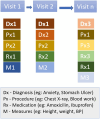Clinical risk prediction using language models: benefits and considerations
- PMID: 38412328
- PMCID: PMC11339498
- DOI: 10.1093/jamia/ocae030
Clinical risk prediction using language models: benefits and considerations
Abstract
Objective: The use of electronic health records (EHRs) for clinical risk prediction is on the rise. However, in many practical settings, the limited availability of task-specific EHR data can restrict the application of standard machine learning pipelines. In this study, we investigate the potential of leveraging language models (LMs) as a means to incorporate supplementary domain knowledge for improving the performance of various EHR-based risk prediction tasks.
Methods: We propose two novel LM-based methods, namely "LLaMA2-EHR" and "Sent-e-Med." Our focus is on utilizing the textual descriptions within structured EHRs to make risk predictions about future diagnoses. We conduct a comprehensive comparison with previous approaches across various data types and sizes.
Results: Experiments across 6 different methods and 3 separate risk prediction tasks reveal that employing LMs to represent structured EHRs, such as diagnostic histories, results in significant performance improvements when evaluated using standard metrics such as area under the receiver operating characteristic (ROC) curve and precision-recall (PR) curve. Additionally, they offer benefits such as few-shot learning, the ability to handle previously unseen medical concepts, and adaptability to various medical vocabularies. However, it is noteworthy that outcomes may exhibit sensitivity to a specific prompt.
Conclusion: LMs encompass extensive embedded knowledge, making them valuable for the analysis of EHRs in the context of risk prediction. Nevertheless, it is important to exercise caution in their application, as ongoing safety concerns related to LMs persist and require continuous consideration.
Keywords: electronic health records; large language models; opioid use disorder; risk prediction; substance use disorder.
© The Author(s) 2024. Published by Oxford University Press on behalf of the American Medical Informatics Association. All rights reserved. For permissions, please email: journals.permissions@oup.com.
Conflict of interest statement
The authors have no competing interests to declare.
Figures





References
-
- Shang J, Ma T, Xiao C, et al. Pre-training of graph augmented transformers for medication recommendation. CoRR, abs/1906.00346. 2019.
MeSH terms
Grants and funding
LinkOut - more resources
Full Text Sources
Research Materials

